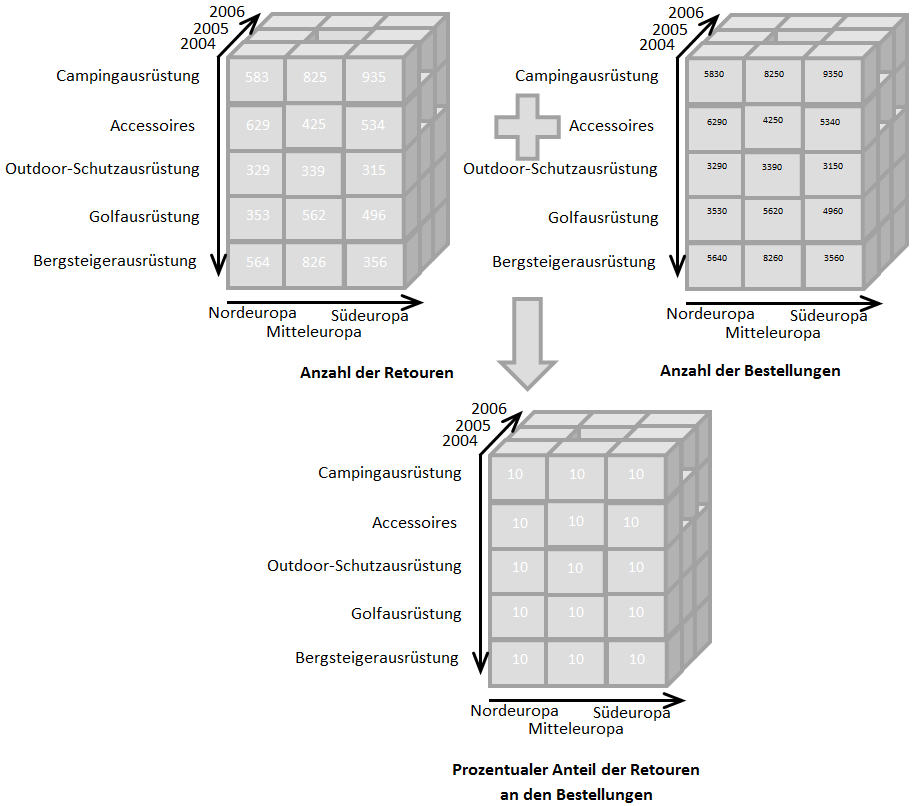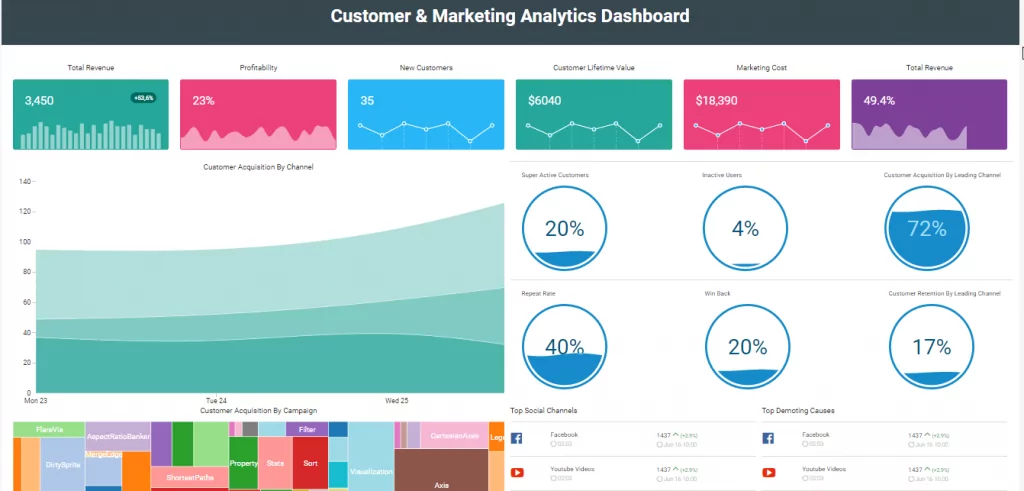Business Intelligence – Definition
Traditionally, Business Intelligence (BI) is a collective term for methods and processes for the systematic analysis of data. Companies use this instrument to make their business processes and customer and supplier relationships more profitable, reduce costs, minimize risks and increase added value. This is done with the help of analytical and organizational concepts and corresponding systems.
In many cases, Business Intelligence is understood as the pure automation of reporting. In this sense, BI is just a methodology for data collection and visualization of interrelationships within the company. The Institute for Business Intelligence expands BI to “the totality of management basics and thus as the integration of strategies, processes and technologies to generate critical knowledge about status, potentials and perspectives from distributed and inhomogeneous company, market and competitor data”. The figure illustrates BI as the overall corporate design of the information and reporting system. At all levels, key performance indicators serve to control corporate processes.
Business Intelligence – process optimization and key figures
Business Intelligence thus refers to process-oriented procedures that require data analysis of company information. The results are usually automatically used by the company management to optimize processes. Thus, BI also stands for the acquisition and dissemination of findings that are made available for all operational processes across companies.
However, many BI projects fail due to not clearly defined key figures. These have to be coordinated with those responsible in the organization. Trust in the agreed key figures is a basic prerequisite for the later acceptance of the results in the corresponding reports. In many cases, it is, therefore, advisable to start with so-called best practice KPIs and iteratively develop your own KPI system from them.
In order to take advantage of the synergies across the various business processes, it is essential to define cross-process values in addition to the key figures for the individual business processes. The knowledge thus gained can then be implemented in the right decisions.
Another possibility for a meaningful use of key figures is the topic of leading indicators. The earlier trends and developments can be read from the data, the more flexible and accurate the corporate strategy and the resulting decisions can be.
Business Intelligence – Strategy and governance
BI thus becomes a management philosophy that serves the company management and the evaluation of strategic competitive advantages. Traditional BI approaches to data provision and visualization are integrated as well as holistic business perspectives. Thus, BI can be extended to become a driver of room for maneuver and strategic competitive advantages.
Implementation example
The Coca-Cola Bottling Company (CCBC) is the largest independent bottling partner of Coca-Cola. With a comprehensive BI strategy, they specifically solved the problem of missing real-time data on both sales and operations. Until the BI strategy was implemented, reports were laboriously generated manually, which also placed a heavy burden on the IT department’s resources. This changed with the introduction of a BI platform. The automation of the reporting processes alone saved hundreds of man-hours per year. However, as the BI team was responsible for all reporting of all sales and delivery activities, the integration of additional company systems enabled the sales staff to be supported efficiently by giving them access to the CRM system data at any time when they were in the field. This enabled them to access meaningful and highly up-to-date information via mobile devices at the customer’s premises, giving them relevant competitive advantages. In addition, the introduction of this holistic BI solution promoted cooperation between the IT department and the company’s end users. This in turn led to analysts and IT staff being able to devote more time to strategic orientation and long-term developments, such as managing corporate data, instead of manually creating reports.
A precisely defined BI strategy is an essential prerequisite for the efficient and effective implementation of BI projects in a company. This strategy should include the following points:
- Definition of BI goals based on the company’s objectives
- Definition of a BI roadmap (short-term, medium-term and long-term goals)
- Standardization and benefits across all departments
- Determination of the relevant key figures and reports from the overall company perspective
- Unification of different key figure worlds to a single point of truth
- Definition of the appropriate tool and the necessary infrastructure
- Centralized or decentralized data storage
The complexity of BI architectures increases with the requirements of different user groups in a company. By introducing BI governance, BI processes as well as organizational structures are created that efficiently support the BI strategy.
In BI governance, all roles involved and their responsibilities are clearly defined. The form of the roles depends on the size of the respective company. An anchored and lived BI strategy and BI governance are necessary in order to keep any discussions about responsibilities to an absolute minimum.
Business Intelligence – The Implementation
When implementing BI projects, three relevant factors need to be considered:
- The strategic orientation
- The management of BI initiatives
- The Best Practice IT Solutions
Clear, robust and field-tested methodologies for the evaluation and definition of key figures and the necessary database are required for strategic alignment. For the management of BI initiatives, in turn, an adequate system architecture is required that offers sufficient performance, is system-independent, can deliver data in real-time and reporting with predefined templates. The end-user is always the focus of the information, which is why data processing, storage and reporting tools are tailored to his information needs. The corresponding IT solutions should therefore primarily serve the end-user.
Accordingly, the technological basis of enterprise data analysis can be divided into three phases:
In the first phase the basic information is collected (quantitative and qualitative). In the second phase, the data is related so that patterns become visible. In the third phase, the findings are communicated within the company and integrated into knowledge management. The dissemination of the gained knowledge should serve to provide a basis for decisions on measures and actions.
1. ETL processes (extraction, transformation and loading processes)
One of the main tasks of a BI project is to transfer the data from the ERP system and other IT systems or external data sources into a separate database (data warehouse) for analysis.
The necessity for this arises for the following reasons:
- The structuring of data in the ERP system is often unsuitable
- There is no possibility of evaluation over several IT systems
- It is not possible to include external data, for example from competitors or research institutes
- The ERP system will be overloaded by the evaluations and because there are constant changes of the data
- 5. The evaluations cannot be repeated or incorrect, incomplete or missing data are present in the IT systems
The transfer is done by extracting the data from the different source systems, transforming it and loading it into the DWH using the standardized ETL processes. These ETL processes offer the possibility to extract the desired source data from the production systems at defined points in time. When extracting the data from the source systems into the DWH, the data can be logically linked according to the needs of the requirement. This turns many individual data elements into first coherent data modules, which form the basis for later evaluations.
2. Data model
The second main task of a BI project is the correct data modeling. In addition to relational data models, multidimensional data models, so-called OLAP cubes, are mainly realized within business intelligence solutions. The performance for the later queries plays an essential role.

After data modeling, data management is the second major factor in the speed of queries. In the course of time, many incorrect or incomplete data are stored in the operative systems. This can consist of incorrect, redundant, inconsistent or incorrectly formatted data. In a DWH, this data can be cleaned up and its contents can be completely prepared for analysis. Thus only correct and complete data is loaded into the corresponding data cubes.
3. Visualization
The third and for the later user most important task of a BI project is the presentation of the agreed key figures on the basis of standard reports, ad hoc reports or dashboards. Using front-end tools, the data from the DWH is visualized and made available to the user via portal technology, e-mail or as business applications on smartphones.

The most important aspect of a business intelligence solution is the user-friendliness and the high query speed of the individual evaluations. Due to the enormous amount of data in a data warehouse, efficient tools are needed which on the one hand meet the requirements of the different end-user groups and on the other hand are embedded in the IT strategy. Great attention must be paid to the consolidation of the front-end tools used.
Business Intelligence in real time
The field of application of business intelligence applications is shifting more and more from classic reporting based on historical transaction data towards real-time analysis. Companies want to analyze the performance of their business units at any time in real-time and see immediately how, for example, customer preferences change. Increasingly, managers are using business intelligence applications to identify business risks and take countermeasures as early as possible.
Business Intelligence as a Service
Due to the BI standardization and the increasing core competence discussions in many companies, the approach to obtain BI-as-a-Service from an external partner is becoming more and more important strategically. The choice ranges from hosting or housing the BI infrastructure, providing the integration level and/or ready-made data cubes to the finished report with the agreed key figures. A dynamic billing model saves major investments and brings significant transparency to the use of a BI system.
The flip side, however, is that an external service provider then also has access to the company data, or has some access to it. As is the case with many external services, the question of the extent to which a company wants to make itself dependent on such service providers is also of no small importance in Business Intelligence.
Conclusion
In practice, Business Intelligence (BI) is the standardization and optimization of reporting. The data accumulated in the IT systems is used to analyze the current situation from different perspectives and, if necessary, to evaluate it. The corresponding analysis is not performed in the ERP systems, but in a separate database, the data warehouse (DWH). Based on this data, decisions are then made that affect the company as a whole, individual areas or processes. The resulting transparency with regard to all business processes means that current, reliable and at all times comprehensible data and control parameters are available in a timely manner. This transparency is then required not only in the management of large and medium-sized companies but in every department. Thus, Business Intelligence should be made as easy as possible for the user. The most important goal here is to provide BI with streamlined processes, standardized reports and complete data integration, because the right decisions can only be made with the right information.
Further information about Business Intelligence can also be found under Key Figures and Key Figure Systems, Information in intralogistics and Master Data.
Also available in Deutsch (German)